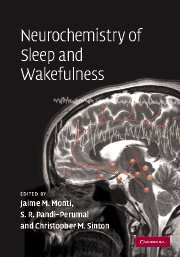Book contents
- Frontmatter
- Contents
- List of contributors
- Preface
- Acknowledgements
- Abbreviations
- I The neurochemistry of the states of sleep and wakefulness
- II The influence of neurotransmitters on sleep and wakefulness
- 4 Gamma-aminobutyric acid and the regulation of paradoxical, or rapid eye movement, sleep
- 5 Acetylcholine modulates sleep and wakefulness: a synaptic perspective
- 6 Histamine in the control of sleep–wakefulness
- 7 Dopamine in behavioral state control
- 8 Glutamate neurotransmission and sleep
- 9 Serotonin and sleep–wake regulation
- III Changing perspectives
- Index
- Plate section
8 - Glutamate neurotransmission and sleep
from II - The influence of neurotransmitters on sleep and wakefulness
Published online by Cambridge University Press: 23 October 2009
- Frontmatter
- Contents
- List of contributors
- Preface
- Acknowledgements
- Abbreviations
- I The neurochemistry of the states of sleep and wakefulness
- II The influence of neurotransmitters on sleep and wakefulness
- 4 Gamma-aminobutyric acid and the regulation of paradoxical, or rapid eye movement, sleep
- 5 Acetylcholine modulates sleep and wakefulness: a synaptic perspective
- 6 Histamine in the control of sleep–wakefulness
- 7 Dopamine in behavioral state control
- 8 Glutamate neurotransmission and sleep
- 9 Serotonin and sleep–wake regulation
- III Changing perspectives
- Index
- Plate section
Summary
Glutamate (Glu) is the main excitatory neurotransmitter in vertebrate brain and GABA is the main inhibitory neurotransmitter. Brain excitability and arousal level therefore depend on the dynamic interplay between Glu and GABA activity: excitability can be lowered by increasing GABA or by decreasing Glu tone. Despite a vast literature on the reduction of arousal and the induction of sleep by GABAergic drugs, Glu has remained relatively neglected. The reason for this unequal treatment is obvious. Drugs that depress brain excitability by stimulating the GABA–benzodiazepine receptor have been extraordinarily useful as hypnotics and short-term anesthetics, and new ones are being constantly developed. However, diminishing returns have now begun to affect the hegemony of the GABAergic hypnotics. Their well recognized limitations include tachyphyllaxis, addiction, and withdrawal syndromes with life-threatening convulsions. Moreover, they induce a sleep pattern with a non-physiological electroencephalogram (EEG) that is typically experienced as non-refreshing. It may thus now be a propitious time to manipulate the other side of the excitation–inhibition equation and examine Glu in more detail. Altering brain excitability by enhancing or depressing Glu transmission could lead to the development of drugs with unique and perhaps more favorable clinical profiles. The discussion in this chapter illustrates the basic science and the clinical potential of this alternative approach.
- Type
- Chapter
- Information
- Neurochemistry of Sleep and Wakefulness , pp. 224 - 243Publisher: Cambridge University PressPrint publication year: 2008
- 1
- Cited by



